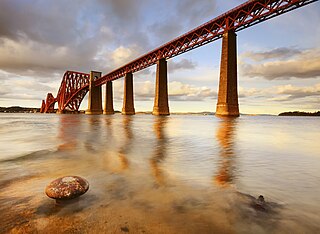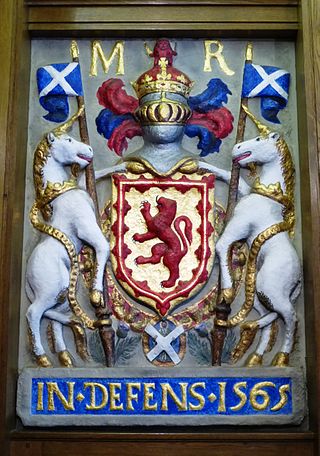
James Peter Hymers Mackay, Baron Mackay of Clashfern, is a British lawyer. He served as Dean of the Faculty of Advocates, Lord Advocate, and Lord Chancellor (1987–1997). He is a former active member of the House of Lords, where he sat as a Conservative. He retired from the House on 22 July 2022.

Norman Alexander MacCaig DLitt was a Scottish poet and teacher. His poetry, in modern English, is known for its humour, simplicity of language and great popularity.

The culture of Scotland refers to the patterns of human activity and symbolism associated with Scotland and the Scottish people. The Scottish flag is blue with a white saltire, and represents the cross of Saint Andrew.
Gordon Donaldson, was a Scottish historian.

Scotland in the Middle Ages concerns the history of Scotland from the departure of the Romans to the adoption of major aspects of the Renaissance in the early sixteenth century.
Sir Thomas Broun Smith was a British lawyer, soldier and academic.

Scots contract law governs the rules of contract in Scotland.

Scotland in the early modern period refers, for the purposes of this article, to Scotland between the death of James IV in 1513 and the end of the Jacobite risings in the mid-eighteenth century. It roughly corresponds to the early modern period in Europe, beginning with the Renaissance and Reformation and ending with the start of the Enlightenment and Industrial Revolution.
Joseph McGeachy Thomson was a Scottish lawyer and academic. He was Regius Professor of Law at the University of Glasgow and a member of the Scottish Law Commission.
David Maxwell Walker was a Scottish lawyer, academic, and Regius Professor of Law at the University of Glasgow.

Scots law is the legal system of Scotland. It is a hybrid or mixed legal system containing civil law and common law elements, that traces its roots to a number of different historical sources. Together with English law and Northern Irish law, it is one of the three legal systems of the United Kingdom. Scots law recognises four sources of law: legislation, legal precedent, specific academic writings, and custom. Legislation affecting Scotland and Scots law is passed by the Scottish Parliament on all areas of devolved responsibility, and the United Kingdom Parliament on reserved matters. Some legislation passed by the pre-1707 Parliament of Scotland is still also valid.

Government in medieval Scotland, includes all forms of politics and administration of the minor kingdoms that emerged after the departure of the Romans from central and southern Britain in the fifth century, through the development and growth of the combined Scottish and Pictish kingdom of Alba into the kingdom of Scotland, until the adoption of the reforms of the Renaissance in the fifteenth century.

The Renaissance in Scotland was a cultural, intellectual and artistic movement in Scotland, from the late fifteenth century to the beginning of the seventeenth century. It is associated with the pan-European Renaissance that is usually regarded as beginning in Italy in the late fourteenth century and reaching northern Europe as a Northern Renaissance in the fifteenth century. It involved an attempt to revive the principles of the classical era, including humanism, a spirit of scholarly enquiry, scepticism, and concepts of balance and proportion. Since the twentieth century, the uniqueness and unity of the Renaissance has been challenged by historians, but significant changes in Scotland can be seen to have taken place in education, intellectual life, literature, art, architecture, music, science and politics.

Architecture of Scotland in the Industrial Revolution includes all building in Scotland between the mid-eighteenth century and the end of the nineteenth century. During this period, the country underwent an economic and social transformation as a result of industrialisation, which was reflected in new architectural forms, techniques and scale of building. In the second half of the eighteenth century, Edinburgh was the focus of a classically inspired building boom that reflected the growing wealth and confidence of the capital. Housing often took the form of horizontally divided tenement flats. Some of the leading European architects during this period were Scottish, including Robert Adam and William Chambers.

Government in early modern Scotland included all forms of administration, from the crown, through national institutions, to systems of local government and the law, between the early sixteenth century and the mid-eighteenth century. It roughly corresponds to the early modern era in Europe, beginning with the Renaissance and Reformation and ending with the last Jacobite risings and the beginnings of the industrial revolution. Monarchs of this period were the Stuarts: James IV, James V, Mary Queen of Scots, James VI, Charles I, Charles II, James VII, William III and Mary II, Anne, and the Hanoverians: George I and George II.

Art in early modern Scotland includes all forms of artistic production within the modern borders of Scotland, between the adoption of the Renaissance in the early sixteenth century to the beginnings of the Enlightenment in the mid-eighteenth century.

Kenneth Gilbert Cameron Reid CBE, FBA, FRSE, WS, is a legal scholar and former law commissioner who holds the Chair of Scots Law at the University of Edinburgh School of Law.

John Shank More LL.D FRSE RSA (1784–1861) was the Chair of Scots Law at the University of Edinburgh which he held from 1843 to 1861. He was involved in the anti-slavery movement and was vice-president of the Royal Scottish Society of Arts.
John David Michael Henry Laver, was a British phonetician. He was Deputy Principal & Deputy Vice Patron as well as Emeritus professor of speech sciences at Edinburgh’s Queen Margaret University, and served as president of the International Phonetic Association from 1991 to 1995.
William Adam Wilson FRSE was a Scottish lawyer who served as Professor of Scots Law at the University of Edinburgh. As an author he was known as W. A. Wilson and informally as Bill Wilson.












